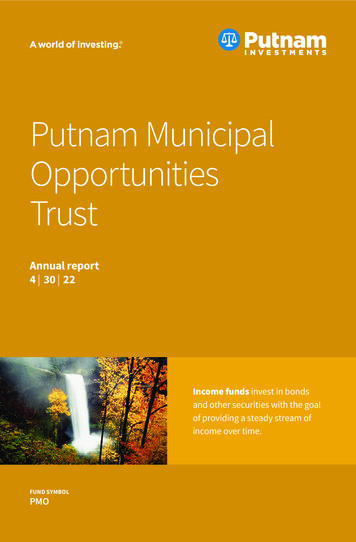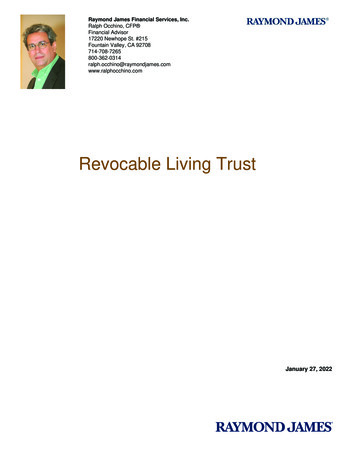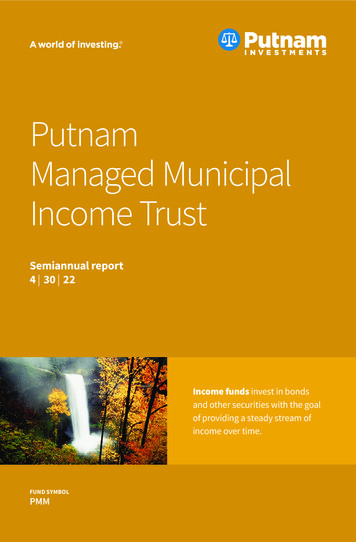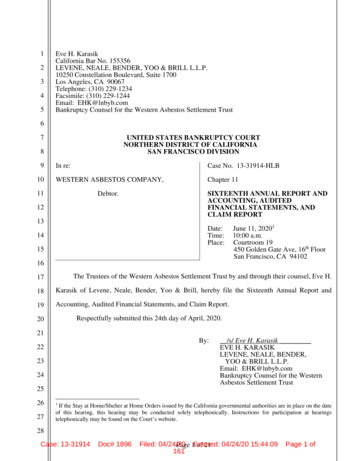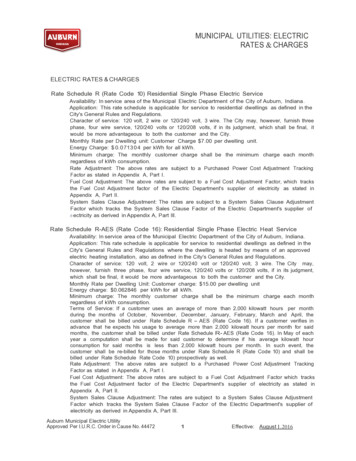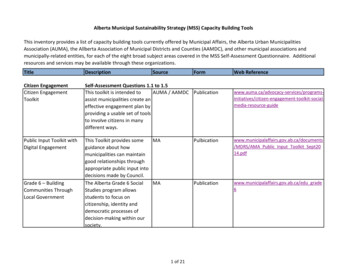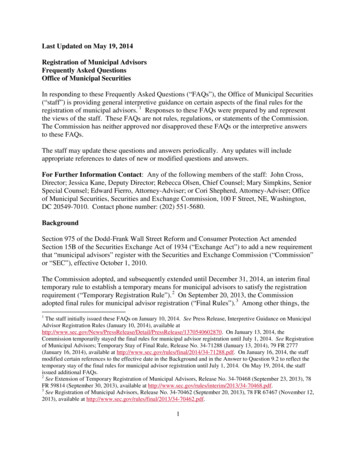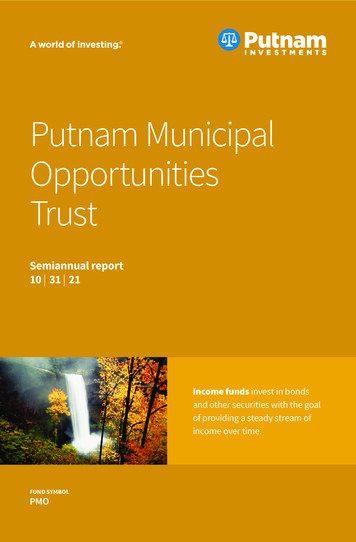
Transcription
Putnam MunicipalOpportunitiesTrustSemiannual report10 31 21Income funds invest in bondsand other securities with the goalof providing a steady stream ofincome over time.FUND SYMBOLPMO
Putnam MunicipalOpportunitiesTrustSemiannual report10 31 21Message from the Trustees1About the fund2Interview with your fund’s portfolio manager5Your fund’s performance10Consider these risks before investing12Terms and definitions13Other information for shareholders14Summary of dividend reinvestment plans15Trustee approval of management contract17Financial statements21Shareholder meeting results53The fund has adopted a managed distribution policy (the “Distribution Policy”) with the goal ofproviding shareholders with a consistent, although not guaranteed, monthly distribution. Inaccordance with the Distribution Policy, the fund currently expects to make monthly distributions tocommon shareholders at a distribution rate per share of 0.0531. Distributions may include ordinaryand/or tax-exempt income, net capital gains, and/or a return of capital of your investment in thefund. You should not draw any conclusions about the fund’s investment performance from theamount of this distribution or from the terms of the Distribution Policy. The Distribution Policyprovides that the Board of Trustees may amend or terminate the Distribution Policy at any timewithout prior notice to fund shareholders.
Message from the TrusteesDecember 15, 2021Dear Fellow Shareholder:In 2021, the stock market had another above-average year. Corporate earnings rose asthe economy reopened and stimulus policies helped increase demand. Bonds, on theother hand, had a subpar year amid higher inflation. To respond to inflation risk, in part,the U.S. Federal Reserve has begun to reduce its monthly asset purchases, a program putin place during the Covid-19 pandemic.Changes and opportunities lie ahead. In November, Congress passed the bipartisanInfrastructure Investment and Jobs Act. It will increase funding for roads, ports, rail,and other projects in the coming decade.As companies continue to adapt to the pandemic, many of them face new challenges,like rebuilding supply chains, hiring workers, and addressing climate risk. Amid all of it,Putnam’s researchers will be actively looking for potential investments to meet the goalsof your fund.Thank you for investing with Putnam.Respectfully yours,Robert L. ReynoldsPresident and Chief Executive OfficerPutnam InvestmentsKenneth R. LeiblerChair, Board of Trustees
About the fundPotential for income exempt fromfederal income taxPutnam Municipal Opportunities Trust has the flexibility to invest in municipal bondsissued by any U.S. state or territory. As a closed-end fund, it shares some commoncharacteristics with open-end mutual funds, but there are some key differences thatinvestors should understand as they consider their portfolio.MORE ASSETS AT WORKOpen-end funds are subject to ongoing sales and redemptions thatcan generate transaction costs for long-term shareholders. Closed-endfunds, however, are typically fixed pools of capital that do not need tohold cash in connection with sales and redemptions, allowing the fundsto keep more assets actively invested.TRADED LIKE STOCKSClosed-end fund shares are traded on stock exchanges. As a result,their prices fluctuate because of the influence of several factors.THEY HAVE A MARKET PRICELike an open-end fund, a closed-end fund has a per-share net assetvalue (NAV). However, closed-end funds also have a “market price” fortheir shares — which is how much you pay when you buy shares of thefund, and how much you receive when you sell them.2 Municipal Opportunities Trust
Looking at a closed-end fund’s performanceYou will usually see that the NAV and the market price differ. The market price canbe influenced by several factors that cause it to vary from the NAV, includingfund distributions, changes in supply and demand for the fund’s shares, changingmarket conditions, and investor perceptions of the fund or its investment manager.PUTNAM MUNICIPAL OPPORTUNITIES TRUSTNet asset valueMarket price16Price per share1412108 5/935/985/035/085/135/1810/21A mix of credit qualitiesIn addition to its flexible geographical focus, Putnam Municipal Opportunities Trustcombines bonds of differing credit quality. The fund invests in high-quality bonds,but also includes an allocation to lower-rated bonds, which may offer higher incomein return for more risk.Municipal Opportunities Trust 3
Performance history as of 10/31/21Annualized total return (%) comparisonThe fund — at NAVPutnam Municipal OpportunitiesTrust (NYSE ticker: PMO)Fund’s benchmarkBloomberg MunicipalBond IndexFund’s Lipper peer group averageGeneral & Insured Municipal DebtFunds (leveraged 93.885.174.563.412.640.47LIFE OF FUND(since 5/28/93)10 YEARS5 YEARS3 YEARS1 YEAR0.010.716 MONTHSData are historical. Past performance does not guarantee future results. More recent returns may be less or more thanthose shown. Investment return and net asset value will fluctuate, and you may have a gain or a loss when you sell yourshares. Performance assumes reinvestment of distributions and does not account for taxes. Fund returns in the bar chartare at NAV. See below and pages 10–11 for additional performance information, including fund returns at market price.Index and Lipper results should be compared with fund performance at NAV. Fund results reflect the use of leverage,while index results are unleveraged and Lipper results reflect varying use of, and methods for, leverage.All Bloomberg indices provided by Bloomberg Index Services Limited.Lipper peer group average provided by Lipper, a Refinitiv company.Recent broad market index and fund performanceU.S. stocks(S&P 500 Index)U.S. bonds(Bloomberg U.S. Aggregate Bond Index)Putnam Municipal Opportunities Trust(at NAV)10.91%1.06%0.47%Cash(ICE BofA U.S. 3-Month Treasury Bill Index)0.01%Fund’s benchmark(Bloomberg Municipal Bond Index)0.01%This comparison shows your fund’s performance in the context of broad market indexes for the six monthsended 10/31/21. See above and pages 10–11 for additional fund performance information. Index descriptionscan be found on page 13.All Bloomberg are indices provided by Bloomberg Index Services Limited.4 Municipal Opportunities Trust
Interview with your fund’s portfolio managerPaul Drury discusses the municipal bondmarket and fund performance for thesix months ended October 31, 2021, aswell as his outlook for the asset class.Paul, how did municipal bonds performduring the reporting period?Paul M. Drury, CFAPortfolio ManagerPaul holds a B.A. from Suffolk University.He has been in the investment industrysince he joined Putnam in 1989.Garrett L. Hamilton, CFA, is also a PortfolioManager of the fund.Municipal bonds encountered headwindsbut delivered slightly positive performance.Mixed economic data, inflation fears, and aspike in Covid-19 cases due to the Delta variantweighed on the asset class in the later monthsof the period.Municipal credit fundamentals continued toimprove during the period. President Biden’ssigning of the 1.9 trillion American Rescue Plan[ARP] in March 2021, which provided a windfallof 350 billion in direct aid to states and localgovernments, remained a tailwind for the assetclass. This aid, coupled with the fact that statebudgets have generally outperformed conservative forecasts, has improved our outlook forsome of the largest credits in the municipalbond market. Furthermore, local municipalitieshave benefited from a strong housing marketand higher revenue from local property taxes.The asset class also benefited from favorablesupply/demand dynamics, which tightenedcredit spreads. [Credit spreads reflect the difference in yield between higher- and lower-ratedmunicipal bonds.] Demand was particularlystrong and helped to support prices. This wasMunicipal Opportunities Trust 5
Credit quality overviewAAA2.6%AA27.0A28.4BBB28.5BB3.5Not rated7.0Cash and net other assets3.0Credit qualities are shown as a percentage of the fund’s net assets (common and preferred shares) as of 10/31/21.A bond rated BBB or higher (SP-3 or higher, for short-term debt) is considered investment grade. This chart reflects thehighest security rating provided by one or more of Standard & Poor’s, Moody’s, and Fitch. Ratings may vary over time.Cash and net other assets, if any, represent the market value weights of cash, derivatives, and short-term securities inthe portfolio. The fund itself has not been rated by an independent rating agency.Portfolio allocation — Top 10 %5.6%NEW YORKOHIO2.8%MASSACHUSETTS6.2%NEW JERSEY6.8%3.8%CALIFORNIAFLORIDA6.8%TEXASTop 10 state allocations are shown as a percentage of the fund’s net assets (common and preferred shares) as of10/31/21. As of 10/31/21, the fund did not have any investments in Puerto Rico. Summary information may differfrom the portfolio schedule included in the financial statements due to the differing treatment of interest accruals,the floating-rate portion of tender option bonds, derivative securities, if any, and the use of different classificationsof securities for presentation purposes. Holdings and allocations may vary over time.6 Municipal Opportunities Trust
due to Treasury yields sitting at historically lowlevels, which pushed investors to seek alternative income opportunities. The pace of inflowsinto municipal bond mutual funds increasedconsiderably as a result. Given the heighteneddemand, the 2021 calendar year will be thelargest inflow year on record, according toLipper, a Refinitiv company. Supply has beenconsistent with that of 2020. However, thecomposition of supply is a bit different, withmore tax-exempt issuance coming to marketthan taxable issuance. We believe this was dueto the tax policy u ncertainty in Washington, D.C.,in the first half of 2021.In September 2021, the Federal Reserve’smessaging became more hawkish when itstated it might begin tapering asset purchasesas early as November 2021. Interest rates movedhigher in response to the announcement andinflation fears, weighing on the performanceof rate-sensitive fixed income securities. Theinflation concerns were stoked by the prospectof higher prices due to supply chain disruptions, rising labor costs, and higher commodityprices. After telegraphing its intentions formonths, the Fed announced its long-awaiteddecision in early November 2021, just after theclose of the period. It would reduce its monthlypurchases of Treasury bonds by 10 billion andmortgage-backed securities by 5 billion permonth beginning that month.How did the fund perform during thereporting period?For the six months ended October 31, 2021, thefund outperformed its municipal benchmarkbut underperformed the average return of itsLipper peer group, General & Insured MunicipalDebt Funds [leveraged closed-end].Note, the Lipper peer group contains funds witha range of investment strategies. Some fundsuse forms of leverage or other return-enhancingmethods that would have improved theirreturns in the recent period, when tax-exemptbonds generally performed well, and lifted theWe believe the currentuncertainties surroundingthe path of inflation andthe course of the pandemiccould lead to increasedinterest-rate volatility.Paul Drurycategory’s average return significantly abovethat of the benchmark index, which does notbenefit from such return-enhancing strategies.What strategies influenced the fund’sperformance during the period?At period-end, the fund held an overweightexposure to investment-grade bonds ratedA and BBB, which are at the lower end of theinvestment-grade spectrum, and an underweight exposure to high-yield bonds relativeto its Lipper peer group. From a sector- orindustry-positioning perspective, we favoredstate-backed, continuing-care retirementcommunity, and charter school bonds relativeto the fund’s Lipper peer group. Duration positioning, a measure of the fund’s interest-ratesensitivity, was generally neutral relative to thelevel of its Lipper peer group at period-end.Regarding our strategy for state debt, the fundheld an overweight exposure to Illinois relativeto the Lipper peer group. We believe Illinois’sfinancial profile continues to stabilize, and itsflexibility and credit fundamentals appear tohave improved since the onset of the Covid-19pandemic in the United States. During theperiod, we decreased the overweight positionslightly as credit spreads tightened due toimproving municipal credit fundamentals andstrong market technicals.We remain cautious about Puerto Ricodue to what we believe to be its seeminglyfragile economy, weak demographictrends, poor-quality infrastructure, volatilepolitical environment, and history of fiscalMunicipal Opportunities Trust 7
mismanagement. As such, the fund, whichdidn’t have any investments in Puerto Ricoat period-end, remained underweight in itsexposure to Puerto Rico municipal debt relativeto its Lipper peer group. We continue to monitorthe Commonwealth’s ongoing restructuringefforts for potential opportunities.How did you use derivatives duringthe period?We utilized swaps to hedge or gain exposureto interest-rate and term-structure risk and tohedge or gain exposure to inflation.What is your outlook for the municipal bondmarket as 2022 begins?The recent infusions under the ARP, fiscalstimulus, and a pickup in economic activityshould help many state and local governmentsenter their 2022 budget sessions with enoughcash on hand to help absorb the economicstress of the pandemic, in our view. InAugust 2021, the Senate passed a 1.2 trillionbipartisan infrastructure bill to repair thenation’s deteriorating roads and bridges,fund new broadband and climate initiatives,and modernize the power grid. [The Housesubsequently passed the infrastructure bill inNovember 2021.] Depending on the detailsof the infrastructure bill, we believe it wouldlikely be a positive development for manymunicipal borrowers, particularly state andlocal governments, transit agencies, airports,and other entities that typically finance transportation infrastructure. In our view, federalgrants for these projects would reduce the needfor municipal borrowers to issue debt to coverthese essential services. This could increasefiscal flexibility for these borrowers whileavoiding higher tax burdens.We believe the current uncertaintiessurrounding the path of inflation and thecourse of the pandemic could lead to increasedinterest-rate volatility. The pandemic-relatedsupply chain and labor market disruptionshave been more persistent than we hadinitially expected, leading to delays and outputshortages that could be with us for some time.The near-term result is an elevated inflationbackdrop that, in our view, will likely weigh onconsumer sentiment and erode demand orencourage the Fed to tighten monetary policyComparison of top sector weightingsHealth careas of 4/30/21as of 10/31/2116.9%15.3%State %9.3%Utilities8.0%9.0%This chart shows how the fund’s top weightings have changed over the past six months. Allocations are shown asa percentage of the fund’s net assets (common and preferred shares). Current period summary information maydiffer from the information in the portfolio schedule notes included in the financial statements due to the inclusionof derivative securities, any interest accruals, the timing of matured security transactions, the use of differentclassifications of securities for presentation purposes, and rounding. Holdings and allocations may vary over time.8 Municipal Opportunities Trust
more quickly. In either case, our near-termoutlook is for slower growth than previouslyexpected and modestly elevated inflation.Municipals were one of the best-performingfixed income asset classes during the first halfof 2021. Given this result, we believe municipalbond returns in the second half of 2021 areunlikely to match the relatively strong resultsof the first half. With current valuations at richlevels versus history, we would view any ratevolatility or a market sell-off as a potentialbuying opportunity. We believe the lower tiersof the investment-grade municipal market,particularly BBB-rated securities, and the highyield market represent some of the best incomeand return opportunities today, but we arebeing selective.We continue to believe municipals offer a highquality, tax-free strategy to garner income intoday’s historically low rate environment.Thank you, Paul, for your time andinsights today.The views expressed in this report are exclusivelythose of Putnam Management and are subject tochange. They are not meant as investment advice.Please note that the holdings discussed in thisreport may not have been held by the fund for theentire period. Portfolio composition is subject toreview in accordance with the fund’s investmentstrategy and may vary in the future. Currentand future portfolio holdings are subject to risk.Statements in the Q&A concerning the fund’sperformance or portfolio composition relative tothose of the fund’s Lipper peer group may referenceinformation produced by Lipper Inc. or through athird party.Municipal Opportunities Trust 9
Your fund’s performanceThis section shows your fund’s performance, price, and distribution information for periods endedOctober 31, 2021, the end of the first half of its current fiscal year. In accordance with regulatoryrequirements for mutual funds, we also include performance information as of the most recentcalendar quarter-end. Performance should always be considered in light of a fund’s investmentstrategy. Data represent past performance. Past performance does not guarantee future results.More recent returns may be less or more than those shown. Investment return, net asset value, andmarket price will fluctuate, and you may have a gain or a loss when you sell your shares.Fund performance Total return and comparative index results for periods ended 10/31/21AnnualaverageLife offund(since5/28/93)10 yearsAnnualaverage5 yearsAnnualaverage3 yearsAnnualaverage1 year6 0%0.47%Market omberg MunicipalBond Index4.9946.273.8818.283.4116.345.172.640.01Lipper General & InsuredMunicipal Debt Funds(leveraged closed-end)category formance assumes reinvestment of distributions and does not account for taxes.Index and Lipper results should be compared with fund performance at net asset value. Fund results reflect the useof leverage, while index results are unleveraged and Lipper results reflect varying use of, and methods for, leverage.All Bloomberg indices are provided by Bloomberg Index Services Limited.* Over the 6-month, 1-year, 3-year, 5-year, 10-year, and life-of-fund periods ended 10/31/21, there were 59, 58, 51, 50,45, and 23 funds, respectively, in this Lipper category.Performance includes the deduction of management fees and administrative expenses.10 Municipal Opportunities Trust
Fund price and distribution information For the six-month period ended 10/31/21DistributionsNumber6Income 1 0.3186Capital gains 2—Total 0.3186Series B(2,876 shares)Distributions — Preferred sharesSeries C(2,673 shares)Number——Income 1 10.83 10.71Capital gains 2Total—— 10.83 10.71Share valueNAVMarket price4/30/21 13.95 13.7210/31/2113.7013.46Current dividend rate (end of period)NAVMarket priceCurrent dividend rate 34.65%4.73%Taxable equivalent 47.857.99The classification of distributions, if any, is an estimate. Final distribution information will appear on your year-endtax forms.1 For some investors, investment income may be subject to the federal alternative minimum tax. Income fromfederally exempt funds may be subject to state and local taxes.2 Capital gains, if any, are taxable for federal and, in most cases, state purposes.3 Most recent distribution, including any return of capital and excluding capital gains, annualized and divided by NAVor market price at end of period.4 Assumes maximum 40.80% federal tax rate for 2021. Results for investors subject to lower tax rates would not beas advantageous.Fund performance as of most recent calendar quarter Total return for periods ended 9/30/21AnnualaverageLife offund (since5/28/93)10 .22%Market price6.167.3933.445.9440.90103.935 yearsAnnualaverage3 yearsAnnualaverage7.79%12.111 year6 months7.47%11.682.51%4.59See the discussion following the fund performance table on page 10 for information about the calculation offund performance.Municipal Opportunities Trust 11
Consider these risks before investingLower-rated bonds may offer higher yields in return for more risk. Bond investments are subjectto interest-rate risk (the risk of bond prices falling if interest rates rise) and credit risk (the risk of anissuer defaulting on interest or principal payments). Interest-rate risk is generally greater for longerterm bonds, and credit risk is generally greater for below-investment-grade bonds. Unlike bonds,funds that invest in bonds have fees and expenses.The value of investments in the fund’s portfolio may fall or fail to rise over extended periods oftime for a variety of reasons, including general economic, political, or financial market conditions;investor sentiment and market perceptions; government actions; geopolitical events or changes;and factors related to a specific issuer, geography, industry, or sector. These and other factors maylead to increased volatility and reduced liquidity in the fund’s portfolio holdings. The fund’s sharestrade on a stock exchange at market prices, which may be lower than the fund’s net asset value.Our investment techniques, analyses, and judgments may not produce the outcome we intend. Theinvestments we select for the fund may not perform as well as other securities that we do not selectfor the fund. We, or the fund’s other service providers, may experience disruptions or operatingerrors that could have a negative effect on the fund. You can lose money by investing in the fund.12 Municipal Opportunities Trust
Terms and definitionsImportant termsTotal return shows how the value of the fund’sshares changed over time, assuming youheld the shares through the entire period andreinvested all distributions in the fund.Net asset value (NAV) is the value of all yourfund’s assets, minus any liabilities, divided bythe number of outstanding shares.Market price is the current trading priceof one share of the fund. Market prices areset by transactions between buyers andsellers on exchanges such as the New YorkStock Exchange.Fixed-income termsCurrent rate is the annual rate of returnearned from dividends or interest of aninvestment. Current rate is expressed as apercentage of the price of a security, fundshare, or principal investment.Yield curve is a graph that plots the yields ofbonds with equal credit quality against theirdiffering maturity dates, ranging from shortestto longest. It is used as a benchmark for otherdebt, such as mortgage or bank lending rates.Comparative indexesBloomberg Municipal Bond Index is anunmanaged index of long-term fixed-rateinvestment-grade t ax-exempt bonds.Bloomberg U.S. Aggregate Bond Index is anunmanaged index of U.S. investment-gradefixed-income securities.performance of U.S. Treasury bills available inthe marketplace.S&P 500 Index is an unmanaged index ofcommon stock performance.Indexes assume reinvestment of all distributions and donot account for fees. Securities and performance of afund and an index will differ. You cannot invest directlyin an index.BLOOMBERG is a trademark and service mark ofBloomberg Finance L.P. and its affiliates (collectively“Bloomberg”). Bloomberg or Bloomberg’s licensorsown all proprietary rights in the Bloomberg Indices.Neither Bloomberg nor Bloomberg’s licensors approveor endorse this material, or guarantee the accuracy orcompleteness of any information herein, or make anywarranty, express or implied, as to the results to beobtained therefrom, and to the maximum extent allowedby law, neither shall have any liability or responsibility forinjury or damages arising in connection therewith.ICE Data Indices, LLC (“ICE BofA”), used with permission.ICE BofA permits use of the ICE BofA indices and relateddata on an “as is” basis; makes no warranties regardingsame; does not guarantee the suitability, quality, accuracy, timeliness, and/or completeness of the ICE BofAindices or any data included in, related to, or derivedtherefrom; assumes no liability in connection with theuse of the foregoing; and does not sponsor, endorse, orrecommend Putnam Investments, or any of its productsor services.Lipper, a Refinitiv company, is a third-partyindustry-ranking entity that ranks mutualfunds. Its rankings do not reflect sales charges.Lipper rankings are based on total return at netasset value relative to other funds that havesimilar current investment styles or objectivesas determined by Lipper. Lipper may changea fund’s category assignment at its discretion.Lipper category averages reflect performancetrends for funds within a category.ICE BofA (Intercontinental Exchange Bank ofAmerica) U.S. 3-Month Treasury Bill Index isan unmanaged index that seeks to measure theMunicipal Opportunities Trust 13
Other information for shareholdersImportant notice regarding sharerepurchase programIn September 2021, the Trustees of your fundapproved the renewal of a share repurchaseprogram that had been in effect since 2005.This renewal allows your fund to repurchase, inthe 365 days beginning October 1, 2021, up to10% of the fund’s common shares outstandingas of September 30, 2021.Important notice regarding delivery ofshareholder documentsIn accordance with Securities and ExchangeCommission (SEC) regulations, Putnam sendsa single notice of internet availability, or asingle printed copy, of annual and semiannual shareholder reports, prospectuses, andproxy statements to Putnam shareholders whoshare the same address, unless a shareholderrequests otherwise. If you prefer to receiveyour own copy of these documents, please callPutnam at 1-800-225-1581, and Putnam willbegin sending individual copies within 30 days.Proxy votingPutnam is committed to managing our mutualfunds in the best interests of our shareholders.The Putnam funds’ proxy voting guidelinesand procedures, as well as informationregarding how your fund voted proxies relatingto portfolio securities during the 12-monthperiod ended June 30, 2021, are available inthe Individual Investors section of putnam.comand on the SEC’s website, www.sec.gov. If14 Municipal Opportunities Trustyou have questions about finding forms onthe SEC’s website, you may call the SEC at1-800-SEC-0330. You may also obtain thePutnam funds’ proxy voting guidelines andprocedures at no charge by calling Putnam’sShareholder Services at 1-800-225-1581.Fund portfolio holdingsThe fund will file a complete schedule of itsportfolio holdings with the SEC for the firstand third quarters of each fiscal year on FormN-PORT within 60 days of the end of suchfiscal quarter. Shareholders may obtain thefund’s Form N-PORT on the SEC’s websiteat www.sec.gov.Prior to its use of Form N-PORT, the fund filedits complete schedule of its portfolio holdingswith the SEC on Form N-Q, which is availableonline at www.sec.gov.Trustee and employee fund ownershipPutnam employees and members of theBoard of Trustees place their faith, confidence,and, most importantly, investment dollarsin Putnam mutual funds. As of October 31,2021, Putnam employees had approximately 584,000,000 and the Trustees had approximately 82,000,000 invested in Putnam mutualfunds. These amounts include investments bythe Trustees’ and employees’ immediate familymembers as well as investments throughretirement and deferred compensation plans.
Summary of Putnam closed-end funds’ amendedand restated dividend reinvestment plansPutnam Managed Municipal Income Trust,Putnam Master Intermediate Income Trust,Putnam Municipal Opportunities Trust andPutnam Premier Income Trust (each, a “Fund”and collectively, the “Funds”) each offer adividend reinvestment plan (each, a “Plan”and collectively, the “Plans”). If you participatein a Plan, all income dividends and capital gaindistributions are automatically reinvestedin Fund shares by the Fund’s agent, PutnamInvestor Services, Inc. (the “Agent”). If you arenot participating in a Plan, every month youwill receive all dividends and other distributions in cash, paid by check and mailed directlyto you.Upon a purchase (or, where applicable, uponregistration of transfer on the shareholder recordsof a Fund) of shares of a Fund by a registeredshareholder, each such shareholder will bedeemed to have elected to participate in thatFund’s Plan. Each such shareholder will have alldistributions by a Fund automatically reinvestedin additional shares, unless such shareholderelects to terminate participation in a Plan byinstructing the Agent to pay future distributionsin cash. Shareholders who were not participantsin a Plan as of January 31, 2010, will continue toreceive distributions in cash but may enroll in aPlan at any time by contacting the Agent.If you participate in a Fund’s Plan, the Agentwill automatically reinvest subsequentdistributions, and the Agent will send you aconfirmation in the mail telling you how manyadditional shares were issued to your account.To change your enrollment status or to requestadditional information about the Plans, youmay contact the Agent either in writing, atP.O. Box 8383, Boston, MA 02266-8383, or bytelephone at 1-800-225-1581 during normalEast Coast business hours.How you acquire additional shares througha Plan If the market price per share for yourFund’s shares (plus estimated brokeragecommissions) is greater than or equal to theirnet asset value per share on th
About the fund Potential for income exempt from federal income tax Putnam Municipal Opportunities Trust has the flexibility to invest in municipal bonds issued by any U.S. state or territory. As a closed-end fund, it shares some common characteristics with open-end mutual funds, but there are some key differences that
